Alamut. Meaning “eagle’s nest” in Persian, the castle is located in modern-day Iran, about 130 miles (200 kms) north of Tehran. Founded by Wahsūdān ibn Marzubān in 865 AD, the castle was captured by the Isma’ili chief Hasan-i Sabbah in 1090 AD and became the headquarters of the Nizari Isma’ili state.
In Worldbreakers, Alamut Castle is a Signature card for Ruknuddin Khurshah, who is a Void guild Worldbreaker. As a location card, Khurshah can develop it to gain the power necessary to win the game. This is the story of the card’s development.
Back to the Source
Worldbreakers had a fantasy theme during the earliest stages of development. This changed with version v0.4, when I decided on alternate 13th century Asia as the setting for Advent of the Horde. I made a list of notable figures from that period and Rukn al-Din Khurshah, 27th Imam of the Nizari Isma’ili (who are often referred to as “The Order of Assassins” in Western popular culture), was a perfect leader for the Void guild.
The word “Horde” comes from the Mongol ordu, which is similar to clan or tribe. A friend pointed out that “horde” has been appropriated by Blizzard’s World of Warcraft. Following his suggestion, I renamed the game to Advent of the Khanate (pronounced KHAN-ate).
Another big change in v0.4 was the introduction of Signature cards, costed at 1, 2, and 3 standing. I drafted three cards for Khurshah, and his 2-standing card was none other than Alamut Castle.
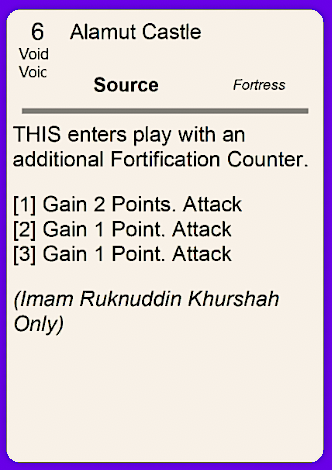
I designed Alamut Castle “top down”, starting with the idea of Khurshah’s castle and deciding on mechanics based on the theme. Looking at this old version, I am surprised both at the similarities and the changes. The card costs 6 mythium, close to today’s 7 mythium. It is a Fortress, has three stages, gives a total of 4 power (called points at the time), and allows you to attack when developed. All of these still exist in today’s version.
There are three differences. One, the card design is vertical instead of horizontal. Two, the type is “Source”, a source of power and mythium (the game’s win condition and currency, respectively). Three, Alamut enters play with an additional “fortification counter”. This mechanic no longer exists in the current version of the game. Back then, if a fortified source was damaged, a fortification counter was removed instead of a stage counter.
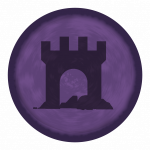
The first change to Alamut Castle came in version v0.63:
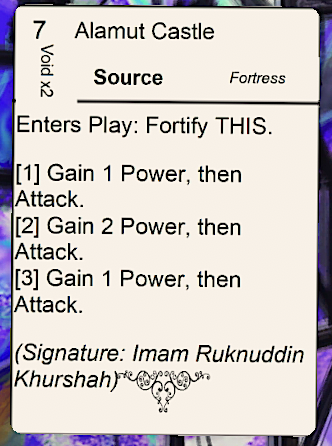
The action efficiency gained by the free attacks made Alamut Castle slightly too strong. The card was nerfed by increasing the cost to 7 mythium and shifting the “Gain 2 Power” effect to stage II, which is slightly riskier. Stage I can be triggered relatively easily by playing the card “on the wheel”, that is, as turn 4 on a round where the turn tracker flips and you become first on the following round. Getting stage II requires more planning.
The Big 7
v0.7 marks several big changes, not just for Alamut Castle, but for Worldbreakers as a whole:
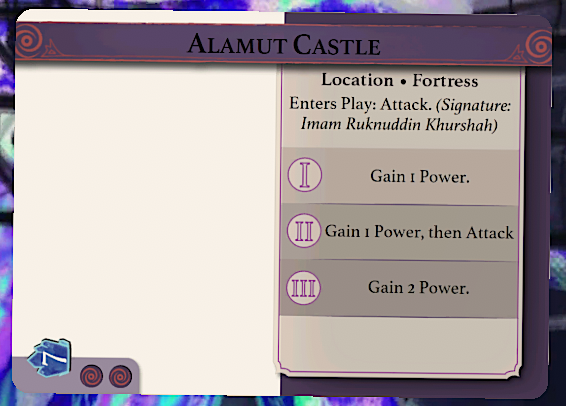
First and foremost, two new people joined the team: Jamie Perconti, the Worldbreakers rules manager, and Alec Zemper, our graphics designer. Jamie was quick to point out that the term “Source” is unclear. We decided to rename the card type to “Location”. In parallel, Alec designed the card template and Void guild symbol, both of which are seen here.
Straight to the Source was originally a pun on the the card type. Since the type changed to “Location”, it is now a homage to this old term. Thankfully I managed to throw in another pun with Surprising Development 😉
Alamut itself changed mechanically as well. The fortification counter was lost in favor of an additional attack. Fortification counters ended up being too strong and were phased out entirely several versions later. To balance the free attack, the attacks in stage I and III were removed. Furthermore, the “Gain 2 power” effect was bumped all the way down to stage III.
v0.72 included a momentous addition:
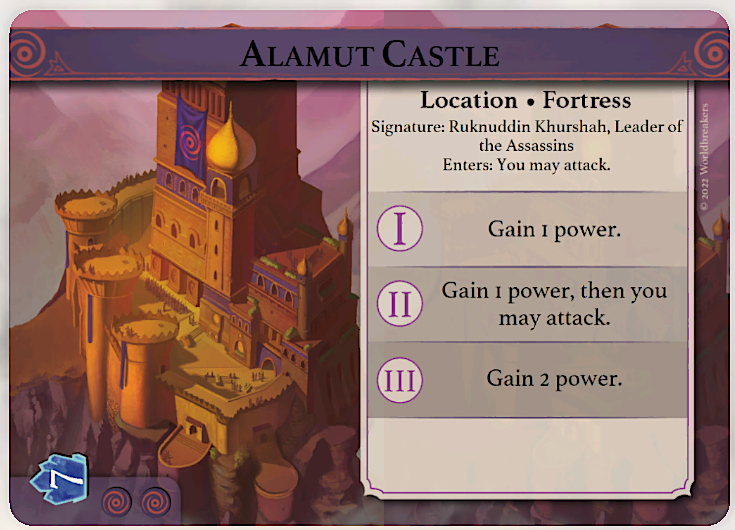
There she is, Alamut Castle, in all of her glory! Alamut was drawn by Agustín Castro, who started from photos of the archeological site and reimagined the Worldbreakers version by incorporating real-world Muslim motifs and fantastic Void guild elements. The illustration is full of details and is one of my favorites:
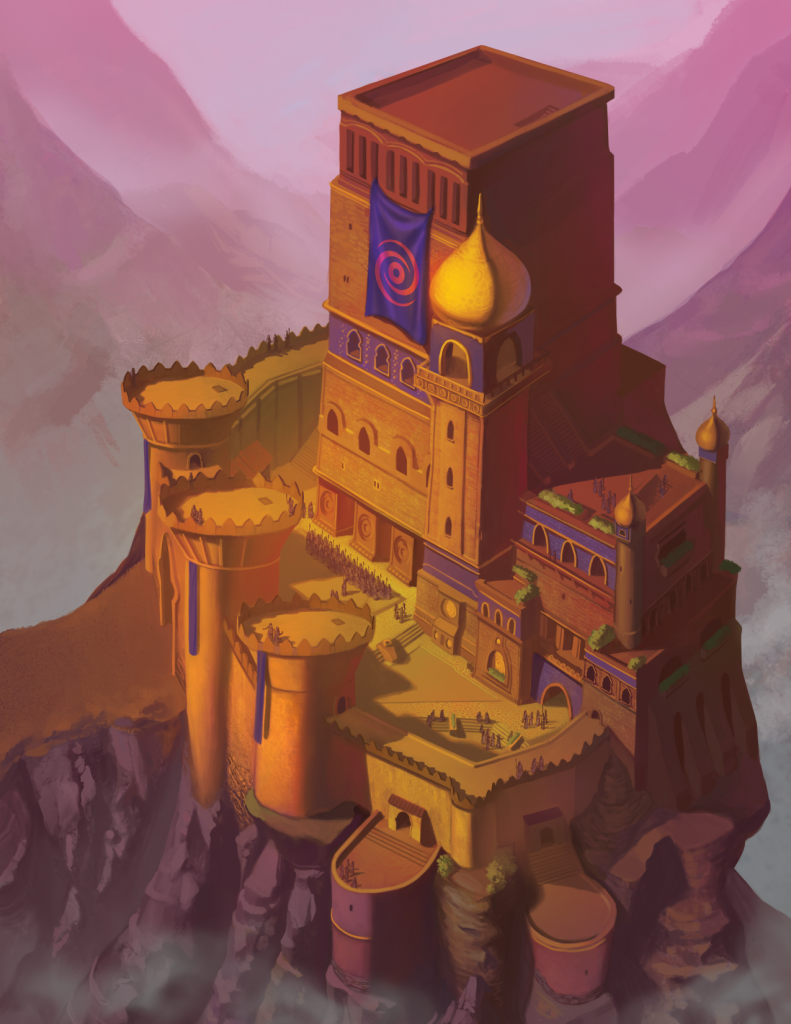
Mechanically, the only difference is changing “Attack” to “you may attack” due to an update to how attacks are managed in the core game rules. Similarly, v0.8 had just a small tweak with the addition of the purple star marking this as a Signature card:
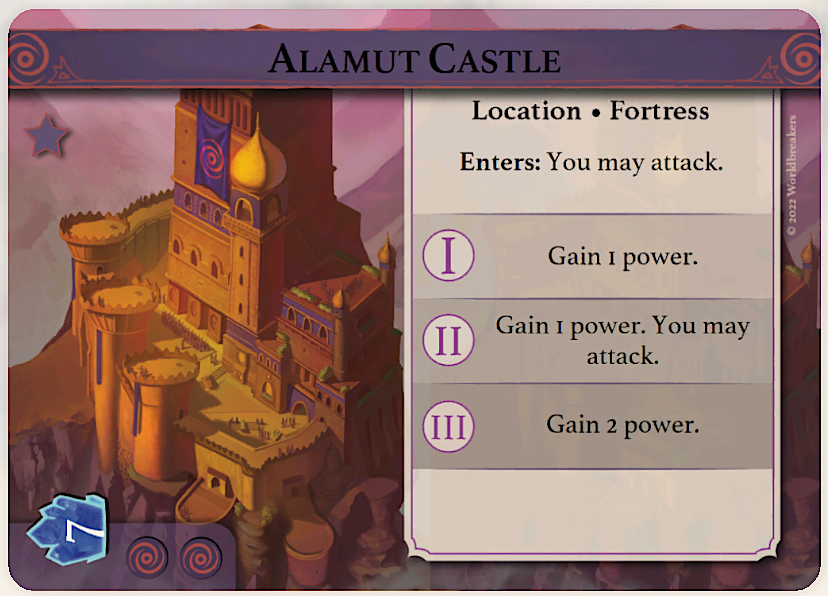
We have reached the current version of Alamut Castle. When you install the Worldbreakers Tabletop Simulator module or download the Print-and-Play, this is the version that you see.
Brick by Brick
In the months since v0.7, I noticed a concerning trend when playtesting: I was not including Alamut Castle in my Ruknuddin Khurshah decks. Apart from the preconstructed deck, I always decided to cut it. This was true in both constructed and draft. Other Khurshah players did the same. The card was balanced, but it was not seeing play.
In my opinion, there are two reasons for Alamut’s disappearance. One, the Void guild has a similar card with Raider’s Hideaway. While the Hideaway gives two less power, it is only 5 mythium to play and gains you 6 mythium when developed. The Void is the poorest of the guilds, and the mythium from Raider’s Hideaway provides fuel for expensive cards such as The Ancient Butcher and Pernicious Powder. Two, Khurshah’s playstyle involves meticulously controlling the board. Spending actions on “just” gaining power does not help with that goal.
Therefore, I was excited to buff Alamut Castle with the next version:
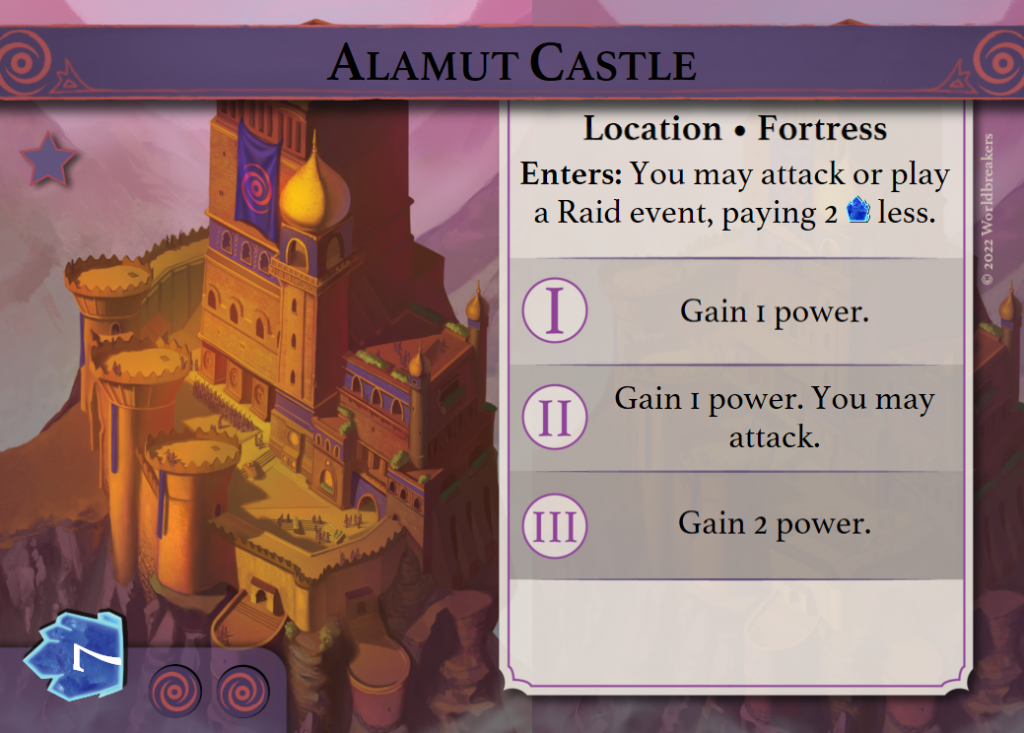
The Void guild has an arsenal of powerful Raid events such as Stupefy and Consumed by the Dust. Alamut Castle offers action efficiency by allowing you to play one as it enters play. Furthermore, it provides an economic boost, both directly (through the two mythium discount) and indirectly (since some Raid events provide mythium). I liked this ability on a Void card since it should play well with the rest of the guild’s strengths.
However, as Jamie and I were discussing Alamut Castle, they asked a tricky question: What do these abilities have to do with Khurshah and his fortress? This is not just a Void card. This is a Signature card. What is its role in the design of the Worldbreaker? How do they complement each other?
The Eagle's Nest
And so, starting with the next version, we will return to Alamut’s origins:
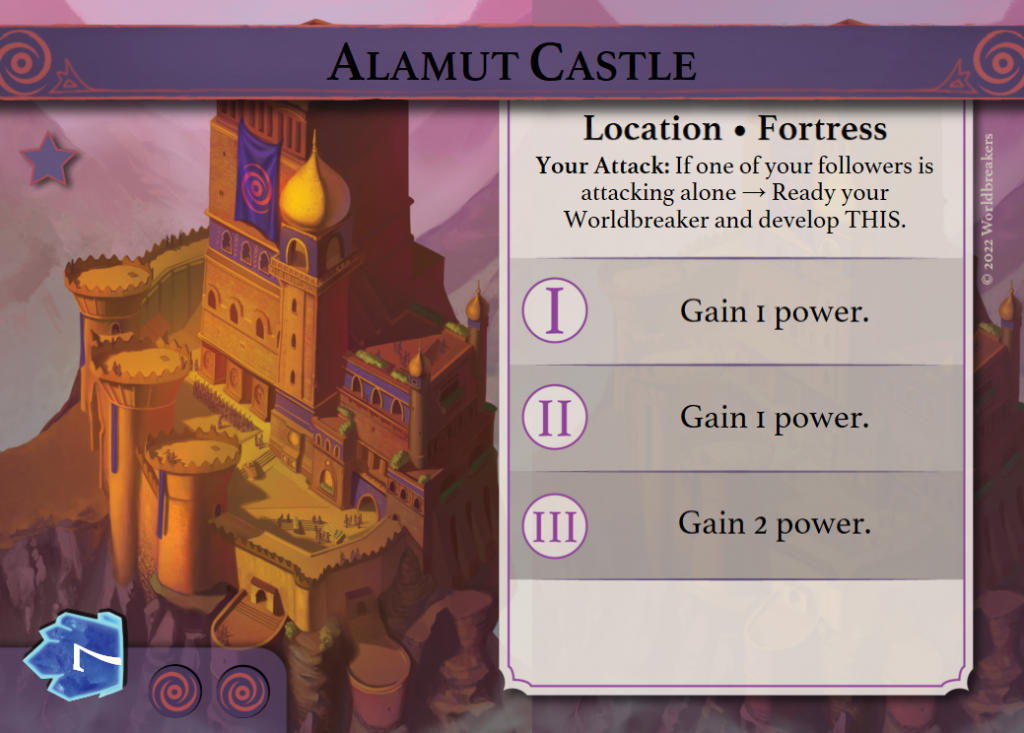
Alamut Castle now develops whenever you attack with a single follower. It is very similar to v0.4, where every develop allowed you to attack. However, the directionality is reversed, which is a significant buff: you can play a Raid event such as Amazing Arithmetic, attack with a single follower, and develop Alamut for power. The Castle synergizes very well with other Void cards, especially Swirling Skirmisher (which could develop Alamut twice in one turn).
We also wanted Alamut Castle to complement Ruknuddin Khurshah. Khurshah has a strong ability: once per round, he allows you to pay one mythium to wound a follower. When he commands from his home, Khurshah gets to ready whenever Alamut is triggered, which means you could wound opposing followers again and again. Keep the mythium flowing and the guild will reward you with a truly terrifying weapon.
Void fans will rejoice at the upcoming change to Alamut Castle. Other guilds should tremble in fear. The only assurance I can give you is that v0.9 includes changes to seventeen additional cards. I can’t wait to share them with you later this week.
Quick reminder that the Worldbreakers Kickstarter campaign is still running, at least at the time of this writing 😉 if you’re intrigued by this design dairy, you’re welcome to browse through past blog posts, and please check out the campaign.